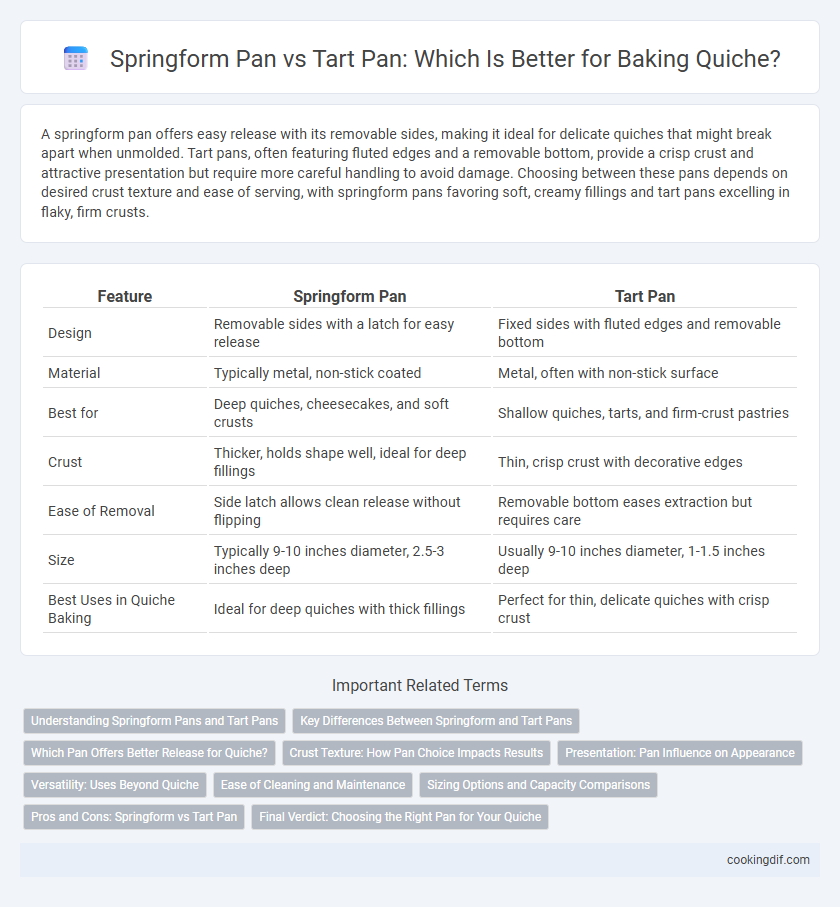A springform pan offers easy release with its removable sides, making it ideal for delicate quiches that might break apart when unmolded. Tart pans, often featuring fluted edges and a removable bottom, provide a crisp crust and attractive presentation but require more careful handling to avoid damage. Choosing between these pans depends on desired crust texture and ease of serving, with springform pans favoring soft, creamy fillings and tart pans excelling in flaky, firm crusts.
Table of Comparison
| Feature | Springform Pan | Tart Pan |
|---|---|---|
| Design | Removable sides with a latch for easy release | Fixed sides with fluted edges and removable bottom |
| Material | Typically metal, non-stick coated | Metal, often with non-stick surface |
| Best for | Deep quiches, cheesecakes, and soft crusts | Shallow quiches, tarts, and firm-crust pastries |
| Crust | Thicker, holds shape well, ideal for deep fillings | Thin, crisp crust with decorative edges |
| Ease of Removal | Side latch allows clean release without flipping | Removable bottom eases extraction but requires care |
| Size | Typically 9-10 inches diameter, 2.5-3 inches deep | Usually 9-10 inches diameter, 1-1.5 inches deep |
| Best Uses in Quiche Baking | Ideal for deep quiches with thick fillings | Perfect for thin, delicate quiches with crisp crust |
Understanding Springform Pans and Tart Pans
Springform pans feature removable sides secured by a latch, ideal for delicate quiches with fragile crusts that require gentle removal without flipping. Tart pans have a solid, often fluted bottom with a removable ring, providing even heat distribution and a crisp, uniform crust texture essential for classic quiche presentations. Choosing between a springform pan and a tart pan depends on desired crust texture and ease of serving.
Key Differences Between Springform and Tart Pans
Springform pans feature removable sides secured by a latch, allowing easy release of delicate quiches without damaging their crust, while tart pans have fixed, shallow sides with a detachable bottom for crisp edges. Springform pans typically offer deeper walls ideal for thicker quiches, contrasting with the shallower design of tart pans that promote even browning and a flakier crust. The choice between pans depends on desired crust texture and quiche thickness, with springform pans better suited for custard-based quiches and tart pans favoring shortcrust varieties.
Which Pan Offers Better Release for Quiche?
Springform pans offer better release for quiche due to their removable sides, allowing easy detachment without damaging the crust or filling. Tart pans with removable bottoms also facilitate release but may cause crust breakage if not handled carefully. Non-stick coatings on both types enhance release, though springform pans provide more stability during baking.
Crust Texture: How Pan Choice Impacts Results
Springform pans create a thicker, softer crust due to their higher, removable sides that retain more moisture during baking. Tart pans, especially those with fluted edges and removable bottoms, promote a crispier, evenly browned crust by allowing direct heat exposure and better air circulation. Choosing between springform and tart pan directly influences the quiche crust texture, balancing tenderness versus crispness based on baking preferences.
Presentation: Pan Influence on Appearance
A springform pan provides smooth, straight sides that create a clean, modern look for quiches, making it ideal for elegant presentation. In contrast, a tart pan, often with fluted edges and a removable bottom, imparts a decorative, rustic appearance that enhances visual appeal. Choosing between the two depends on whether a sleek or traditional aesthetic is desired for the final dish.
Versatility: Uses Beyond Quiche
A springform pan offers exceptional versatility beyond quiche, ideal for delicate desserts like cheesecakes and layered cakes due to its removable sides that simplify serving. Tart pans, with their fluted edges and removable bottoms, excel in creating visually appealing tarts and pies, but their rigid shape limits use for soft or layered dishes. Choosing between these pans depends on whether you prioritize versatility for various baked goods or specialized presentation for tarts.
Ease of Cleaning and Maintenance
A springform pan offers easier cleaning due to its removable sides, allowing access to hard-to-reach edges and preventing crust breakage during removal. Tart pans, often featuring fluted edges and removable bottoms, require more careful cleaning to maintain their intricate design and avoid damage. Both pans benefit from non-stick coatings, but the springform pan generally simplifies maintenance and reduces dishwasher wear.
Sizing Options and Capacity Comparisons
Springform pans typically offer adjustable sizing options ranging from 6 to 12 inches, providing greater capacity flexibility for quiches of various sizes. Tart pans often come in fixed diameters, commonly 9 to 11 inches, with shallower depths that limit volume but create ideal crust-to-filling ratios. For larger quiches or recipes requiring deeper fillings, springform pans provide superior capacity, while tart pans excel in creating visually appealing, shallower pastries.
Pros and Cons: Springform vs Tart Pan
A springform pan offers easy removal with its removable sides, ideal for delicate quiches without damaging the crust, but it may lack the crisp edges a tart pan provides due to its straight sides. Tart pans, typically with fluted edges and a removable bottom, create a visually appealing crust with a crispier texture but can be more challenging to release cleanly, risking cracking. Choosing between them depends on whether ease of serving or presentation and texture of the crust is prioritized for quiche baking.
Final Verdict: Choosing the Right Pan for Your Quiche
A springform pan offers easy removal and clean edges, ideal for delicate quiche with a crumbly crust, while a tart pan with a removable bottom provides crisp, even baking and attractive fluted edges. For quiche recipes prioritizing texture and presentation, tart pans yield a more professional finish without compromising structural integrity. Ultimately, selecting between springform and tart pans depends on the desired crust firmness and ease of serving.
Springform pan vs tart pan for baking Infographic

 cookingdif.com
cookingdif.com